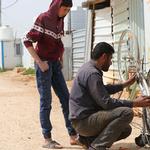From camp to quarter: the contention of post-disaster social housing in al-Mankubin, North Lebanon
The neighbourhood of al-Mankubin was established as an encampment for the displaced of Tripoli, North Lebanon, after a disastrous flood in 1955. This article analyses the history of a lesser-known internal displacement camp in Lebanon and its urban consolidation. In contrast to narratives of Mankubin’s abandonment by the state, this article argues that actors within Lebanon’s fragmented state supported the establishment and growth of the quarter. The issue of squatting on state-owned land is interrogated through an analysis of the flood relief process in the 1950s and the subsequent derailment of the housing project for the flood-displaced. Today, al-Mankubin sits at the intersection of social housing and encampment, perpetuated over seven decades by the absence of land tenure and as a site of convergence for displaced persons and migrants from Lebanon, Palestine, and Syria.
https://doi.org/10.1093/jrs/feae073




